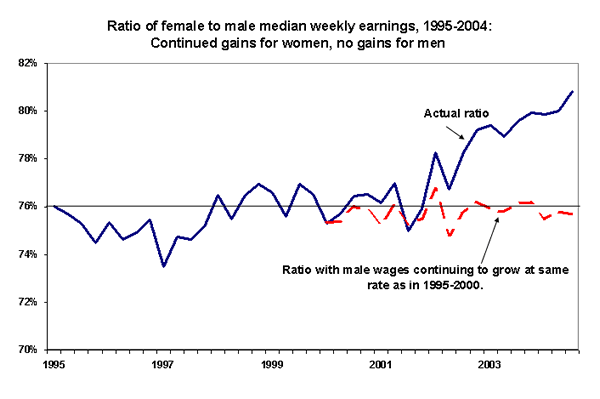See Snapshots Archive.
Snapshot for January 5, 2005.
Slowdown in male earnings leads to smaller gender wage gap
A recent article in the New York Times focused on the trend in the gender wage gap—the ratio between female and male median weekly earnings1. As the figure below reveals, this ratio hovered around 76% throughout the late 1990s, meaning that the median female worker earned $0.76 for each dollar earned by the median male.
With the onset of recession in 2001, the gender wage gap began to close, and by the third quarter of 2004 the ratio had risen to about 81%. This marked its highest level on record, going back to 1979 (implying the narrowest gender gap recorded over this period). What explains this sharp rise?
Since this value is the ratio of two wage series, we can gain insight into what’s driving its increase by examining each gender’s wage trend. In fact, both series increased at an annual rate of about 1.5% per year between 1995 and 2000. But since then, real male median earnings have been flat, while women’s earnings have continued to rise at that same rate. The figure shows the impact of this shifting trend by simulating the gender gap had male wages continued to increase at their 1995-2000 pace (see the dotted line in the figure). Had this occurred—if male earnings had not decelerated—the gender wage gap would not have narrowed.

Thus, the closing of the gap was due exclusively to male workers losing ground relative to women. This relates in part to the fact that male-dominated industries, such as manufacturing, were hit especially hard by the recession and jobless recovery, which lead to job losses and diminished wage growth. At the same time, some female-dominated industries, such as health care, continued to expand.
This result should not be taken to imply that all women were insulated from the impact of the weak post-2000 job market. In fact, compared to past downturns, more women were displaced by the recession and jobless recovery (see, for example, October 27, 2004 Snapshot titled Female job seekers have fewer opportunities than in the past). However, women who kept their jobs experienced better wage trends than men.
1. See “Women are Gaining Ground on the Wage Front,” by Louis Uchitelle, December 31, 2004, New York Times.
Source: Data are from the Bureau of Labor Statistics series of median weekly earnings for full-time workers, seasonally adjusted by EPI.
Today’s Snapshot was written by EPI Senior Economist Jared Bernstein.
